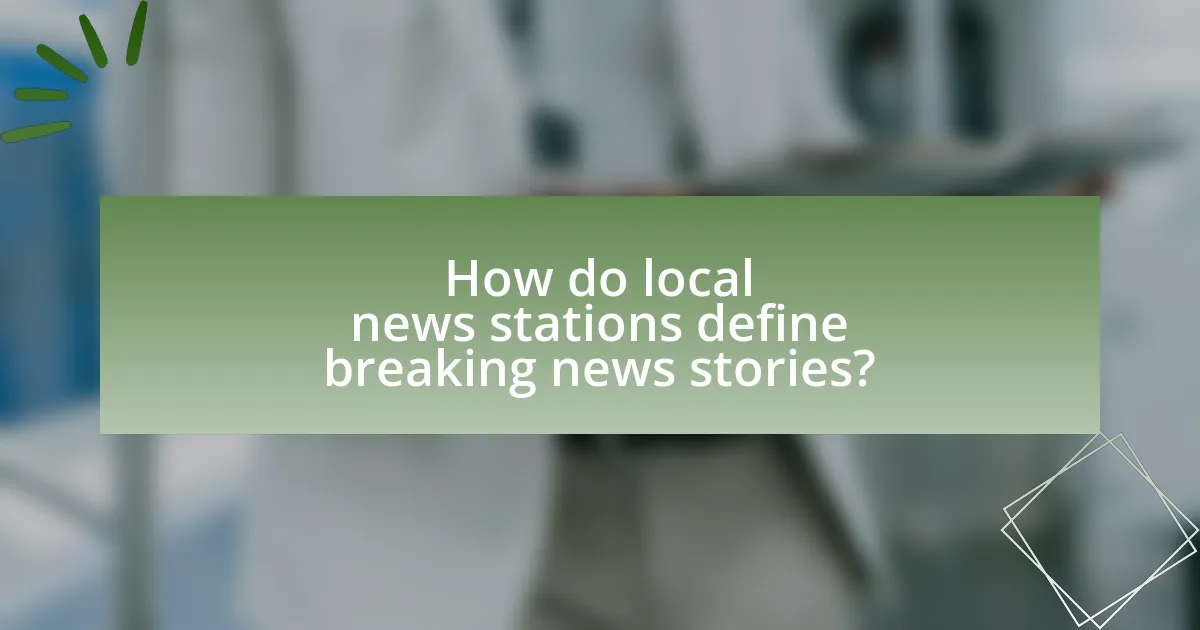Local news stations play a crucial role in defining and reporting breaking news stories, which are characterized by their significance and urgency. These stories often encompass natural disasters, major accidents, criminal activities, and significant political developments, necessitating immediate coverage to inform and protect the community. The article outlines the criteria used by local news stations to identify breaking news, including immediacy, significance, proximity, and audience interest. It also discusses the importance of timely reporting, the challenges faced by news stations in delivering updates, and the processes involved in gathering and verifying information. Additionally, the article highlights the impact of technology and audience engagement on news dissemination and credibility, as well as best practices for ethical reporting during breaking news events.

How do local news stations define breaking news stories?
Local news stations define breaking news stories as significant, urgent events that require immediate coverage due to their impact on the community. These stories often include natural disasters, major accidents, criminal activities, or significant political developments. The urgency is underscored by the need for timely information dissemination to keep the public informed and safe, as evidenced by the practice of interrupting regular programming to report on such events.
What criteria do local news stations use to identify breaking news?
Local news stations identify breaking news based on criteria such as immediacy, significance, proximity, and human interest. Immediacy refers to the urgency of the event, where events occurring right now or very recently are prioritized. Significance involves the impact of the news on the community, such as major accidents, natural disasters, or significant political events. Proximity considers how close the event is to the station’s audience, with local events receiving more attention. Human interest stories, which evoke emotional responses, also play a role in determining what qualifies as breaking news. These criteria ensure that the news reported is relevant and timely for the audience.
How does the urgency of a story influence its classification as breaking news?
The urgency of a story significantly influences its classification as breaking news by determining the immediacy with which it is reported. Stories that involve imminent threats, such as natural disasters or active criminal incidents, are prioritized for immediate broadcast due to their potential impact on public safety. For instance, the 2011 Joplin tornado was classified as breaking news because it posed an immediate danger to residents, prompting local news stations to interrupt regular programming to provide real-time updates. This classification is supported by the need for timely information dissemination, as urgent stories often require swift action from the public, thereby elevating their status in news reporting.
What role does audience interest play in determining breaking news?
Audience interest is a critical factor in determining breaking news, as it influences what stories are prioritized and reported by local news stations. News organizations analyze audience engagement metrics, such as viewership ratings and social media interactions, to identify topics that resonate with their audience. For instance, a study by the Pew Research Center found that local news outlets often focus on stories that generate high public interest, such as crime, local events, or significant political developments, to maintain viewer engagement and advertising revenue. This alignment with audience preferences ensures that news coverage remains relevant and impactful.
Why is timely reporting important for breaking news?
Timely reporting is crucial for breaking news because it ensures that the public receives accurate and relevant information as events unfold. When news is reported promptly, it allows individuals to make informed decisions, especially in situations involving public safety, such as natural disasters or emergencies. For instance, during the 2011 Joplin tornado, timely updates from local news stations helped residents evacuate and seek shelter, significantly reducing potential casualties. Furthermore, timely reporting helps to prevent the spread of misinformation, as immediate coverage can clarify facts and dispel rumors. This is supported by studies showing that rapid dissemination of information during crises leads to better community responses and outcomes.
How does the speed of reporting affect public perception?
The speed of reporting significantly influences public perception by shaping the immediacy and emotional response to news events. Rapid reporting can create a sense of urgency and heightened awareness among the audience, often leading to increased engagement and discussion. For instance, during crises such as natural disasters or terrorist attacks, timely updates can inform the public about safety measures and developments, thereby affecting their behavior and decision-making. Conversely, if reporting is too swift, it may lead to the dissemination of inaccurate information, which can distort public understanding and trust. Research indicates that 60% of individuals are more likely to believe breaking news when it is reported quickly, but this belief can diminish if subsequent corrections are not communicated effectively. Thus, the balance between speed and accuracy is crucial in shaping how the public perceives and reacts to news stories.
What challenges do local news stations face in delivering timely updates?
Local news stations face significant challenges in delivering timely updates, primarily due to resource constraints, technological limitations, and competition from digital platforms. Resource constraints often manifest as limited staff and budget, which hinder the ability to cover breaking news effectively. For instance, a study by the Pew Research Center in 2020 highlighted that nearly 60% of local newsrooms operate with fewer than 10 full-time journalists, impacting their capacity to respond quickly to emerging stories.
Technological limitations also play a role; many local stations struggle with outdated equipment and insufficient training in new media technologies, which can delay the dissemination of information. Furthermore, competition from social media and online news outlets accelerates the demand for immediate updates, pressuring local stations to keep pace despite their operational challenges. This combination of factors complicates the ability of local news stations to provide timely and accurate news coverage.

What processes do local news stations follow to cover breaking news?
Local news stations follow a structured process to cover breaking news, which typically includes monitoring news alerts, gathering information, verifying facts, and broadcasting updates. Initially, newsrooms utilize various sources such as police scanners, social media, and tips from the public to identify breaking news events. Once an event is identified, reporters are dispatched to the scene to gather firsthand information and conduct interviews with witnesses or officials.
Verification of facts is crucial; reporters cross-check information with reliable sources to ensure accuracy before airing any details. This process often involves collaboration with editors and producers to determine the most relevant information to present. Finally, local news stations broadcast live updates or produce news segments that provide viewers with timely and accurate coverage of the breaking news event. This systematic approach ensures that the information disseminated is credible and serves the public interest effectively.
How do local news stations gather information during breaking news events?
Local news stations gather information during breaking news events through a combination of on-the-ground reporting, social media monitoring, and communication with law enforcement and emergency services. Reporters are dispatched to the scene to provide real-time updates, while newsrooms utilize social media platforms to track developments and gather eyewitness accounts. Additionally, local news stations often maintain direct lines of communication with police and fire departments to obtain official information and updates, ensuring accuracy and timeliness in their reporting. This multi-faceted approach allows local news stations to deliver comprehensive coverage during critical events.
What sources do local news stations rely on for accurate information?
Local news stations rely on a variety of sources for accurate information, including official government statements, law enforcement agencies, eyewitness accounts, and reputable wire services. These sources provide verified data and real-time updates essential for reporting breaking news. For instance, law enforcement agencies often issue press releases during incidents, which local news stations use to ensure accuracy. Additionally, eyewitness accounts can provide immediate insights into unfolding events, while wire services like the Associated Press offer vetted news content that local stations can trust.
How do reporters verify information before broadcasting it?
Reporters verify information before broadcasting it by cross-referencing multiple credible sources and utilizing fact-checking protocols. They often consult official statements, eyewitness accounts, and expert opinions to ensure accuracy. For instance, the Associated Press employs a rigorous verification process that includes confirming details with at least two independent sources before reporting. This method helps to minimize the spread of misinformation and maintain journalistic integrity.
What role does technology play in breaking news coverage?
Technology plays a crucial role in breaking news coverage by enabling real-time reporting and instant dissemination of information. Local news stations utilize various technological tools, such as social media platforms, mobile applications, and live streaming services, to quickly share updates with their audience. For instance, during significant events like natural disasters or major accidents, news outlets can leverage satellite imagery and drones to gather and broadcast live footage, enhancing the immediacy and accuracy of their reports. Additionally, data analytics tools help journalists monitor trends and audience engagement, allowing them to tailor their coverage to meet public interest effectively. This integration of technology not only accelerates the news cycle but also fosters greater transparency and accountability in reporting.
How do social media platforms impact the dissemination of breaking news?
Social media platforms significantly accelerate the dissemination of breaking news by enabling real-time sharing and engagement among users. These platforms allow individuals to post updates, share articles, and comment on events as they unfold, often before traditional news outlets can report on them. For instance, during the 2011 Arab Spring, social media was pivotal in spreading information rapidly, with platforms like Twitter and Facebook facilitating the organization of protests and the sharing of live updates. This immediacy can lead to a faster public response and increased awareness, but it also raises concerns about the accuracy of information, as unverified reports can spread quickly.
What tools do local news stations use to enhance their reporting capabilities?
Local news stations enhance their reporting capabilities using tools such as digital cameras, mobile reporting kits, and social media platforms. Digital cameras allow for high-quality video and photo capture, essential for compelling storytelling. Mobile reporting kits, which often include laptops, microphones, and portable editing software, enable journalists to report from the field efficiently. Social media platforms facilitate real-time updates and audience engagement, allowing stations to disseminate information quickly and gather public input. These tools collectively improve the speed, quality, and interactivity of news reporting, which is crucial during breaking news events.

How do local news stations engage with their audience during breaking news?
Local news stations engage with their audience during breaking news by utilizing multiple platforms for real-time updates and interaction. They provide live broadcasts, social media updates, and mobile alerts to ensure timely dissemination of information. For instance, during significant events like natural disasters or public emergencies, stations often employ live streaming on their websites and social media channels, allowing viewers to access information instantly. Additionally, they encourage audience participation through social media by inviting viewers to share their experiences or ask questions, fostering a two-way communication channel. This approach not only keeps the audience informed but also creates a sense of community engagement during critical situations.
What strategies do local news stations use to keep viewers informed?
Local news stations employ several strategies to keep viewers informed, including real-time updates, community engagement, and leveraging digital platforms. Real-time updates are crucial during breaking news events, where stations provide immediate information through live broadcasts and social media channels. Community engagement is fostered through local events, interviews, and feedback mechanisms, allowing viewers to feel connected and involved. Additionally, digital platforms such as websites and mobile apps are utilized to disseminate news quickly and efficiently, ensuring that viewers have access to the latest information anytime. These strategies are supported by research indicating that local news stations that actively engage with their audience and utilize multiple platforms see higher viewer retention and trust.
How do local news stations utilize live updates and alerts?
Local news stations utilize live updates and alerts to provide timely information to their audiences during breaking news events. They employ various platforms, including television broadcasts, social media, and mobile apps, to disseminate real-time updates on critical incidents such as natural disasters, accidents, or public safety threats. For instance, during severe weather events, stations often issue live alerts that inform viewers about storm paths, evacuation orders, and safety precautions, ensuring that the community remains informed and prepared. This approach not only enhances viewer engagement but also fulfills the stations’ role in public service by delivering essential information quickly and efficiently.
What methods do they employ to encourage viewer interaction?
Local news stations employ methods such as social media engagement, live polls, and viewer call-ins to encourage viewer interaction. By utilizing platforms like Facebook and Twitter, they invite viewers to share their opinions and experiences related to breaking news stories. Live polls during broadcasts allow viewers to participate in real-time decision-making, while call-ins provide a direct channel for audience voices to be heard. These strategies not only enhance viewer engagement but also foster a sense of community and immediacy around news events.
Why is audience feedback important during breaking news coverage?
Audience feedback is important during breaking news coverage because it helps local news stations gauge public interest and concerns in real-time. This immediate input allows news organizations to tailor their reporting to address the specific needs and questions of their audience, ensuring that the coverage remains relevant and engaging. For instance, during significant events like natural disasters or public emergencies, audience feedback can highlight critical areas of concern, enabling news outlets to provide timely updates and essential information that directly impacts the community. Additionally, studies have shown that audience engagement can enhance trust and credibility in news reporting, as viewers feel their voices are heard and valued.
How do local news stations incorporate viewer feedback into their reporting?
Local news stations incorporate viewer feedback into their reporting by actively soliciting input through various channels such as social media, phone calls, and emails. This engagement allows stations to gauge audience interests and concerns, which directly influences the selection of stories and the framing of news coverage. For instance, many local news outlets monitor social media platforms to identify trending topics and viewer sentiments, ensuring that their reporting aligns with community interests. Additionally, some stations conduct surveys or polls to gather specific feedback on what issues viewers find most relevant, thereby enhancing the relevance and responsiveness of their news content.
What impact does audience engagement have on the credibility of the news station?
Audience engagement significantly enhances the credibility of a news station. When viewers actively participate through comments, shares, and discussions, it indicates a vested interest in the content, which can lead to increased trust in the station’s reporting. Research shows that news organizations with higher audience interaction often experience improved perceptions of reliability; for instance, a study by the Pew Research Center found that 62% of engaged audiences view their news sources as more trustworthy. This interaction not only fosters a sense of community but also encourages transparency, as stations are more likely to address viewer concerns and correct misinformation, further solidifying their credibility.
What best practices should local news stations follow when handling breaking news?
Local news stations should prioritize accuracy, timely updates, and clear communication when handling breaking news. Accuracy is essential to maintain credibility; therefore, stations must verify information from multiple reliable sources before broadcasting. Timely updates keep the audience informed, necessitating a rapid response to new developments while ensuring that updates are factual. Clear communication involves using straightforward language and avoiding jargon, which helps the audience understand the situation quickly. According to a study by the Pew Research Center, 62% of Americans say they rely on local news for accurate information during emergencies, highlighting the importance of these best practices in fostering trust and effective information dissemination.
How can local news stations ensure accuracy while reporting quickly?
Local news stations can ensure accuracy while reporting quickly by implementing a robust verification process that includes cross-referencing multiple reliable sources before broadcasting information. This approach minimizes the risk of disseminating false or misleading information, which is critical in fast-paced news environments. For instance, the Associated Press emphasizes the importance of confirming facts with at least two independent sources, a practice that has been shown to enhance the credibility of news reports. Additionally, utilizing technology such as real-time fact-checking tools can aid reporters in quickly verifying details, thereby maintaining accuracy even under tight deadlines.
What ethical considerations should be taken into account during breaking news coverage?
During breaking news coverage, journalists must prioritize accuracy, minimizing harm, and respecting privacy. Accuracy is crucial as misinformation can lead to public panic or misunderstanding; for instance, the 2013 Boston Marathon bombing coverage highlighted the dangers of reporting unverified information. Minimizing harm involves considering the emotional and psychological impact on victims and their families, as seen in coverage of natural disasters where sensitive information can exacerbate trauma. Respecting privacy is essential, particularly for individuals involved in sensitive situations, such as crime victims, where revealing identities can lead to further victimization. These ethical considerations ensure responsible journalism that maintains public trust and integrity.




